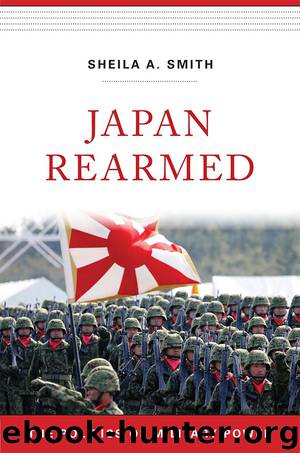Japan Rearmed by Sheila A. Smith

Author:Sheila A. Smith [Sheila A. Smith]
Language: eng
Format: epub
The U.S.-Japan Strategic Bargain
The limitations on Japan’s use of its own military created a strategic dependency on the United States.² As Sakamoto Kazuya argued in his seminal work on the alliance, the lack of military reciprocity in treaty obligations informed Tokyo’s approach to alliance management from the start.³ The trade-off between a U.S. commitment to assist in Japan’s defenses and a Japanese commitment to sponsoring U.S. strategic forces in the region was manageable for most of the Cold War. Attending the treaty was a memorandum of understanding that committed the United States to consultations with the Japanese government on how U.S. forces stationed in Japan might be deployed.⁴
To be sure, each government wanted the other to do more. The United States wanted Japan to build a bigger military and to allow it to contribute more to regional security. Japan wanted the U.S. to manage its military forces on Japanese soil better so as to reduce tensions with the Japanese public. Many in Japan found hosting U.S. forces burdensome, and Tokyo was anxious to reduce the number of U.S. forces on Japanese soil. Popular opposition to U.S. forces peaked during the Vietnam War, and a nationwide antiwar movement brought calls for the U.S. military to leave Japan. This reached residents in Okinawa, who were still under U.S. administration, and fed into local desires for a return to Japanese sovereignty. With the security treaty coming up for renewal in 1970, the intense domestic activism against the treaty prompted the Japanese government to assert its interests with Washington. The Satō-Nixon communiqué of 1969 announced the return of the Ryūkyū and Bonin Islands to Japan. The drawdown of U.S. forces in the wake of the Vietnam War was thus done in tandem with the reversion of Okinawa. The consequence was a consolidation and reduction of U.S. bases on the main Japanese islands while the U.S. military concentrated its forces in Okinawa Prefecture—an outcome that would come back to haunt Japanese leaders in the wake of the Cold War.⁵
Reciprocity in the alliance came under greater scrutiny in the United States once Japan became one of the world’s richest nations. The U.S. government’s frustration with the slow pace of Japanese rearmament had been part and parcel of the alliance dynamic since the alliance began, but as trade frictions with Japan grew in the 1980s, congressional interest in the equities of the U.S.-Japan alliance intensified. The NATO alliance had long discussed greater burden sharing, and the United States and its European allies had agreed on defense spending targets.⁶ This proved to be an ineffective approach with Japan, given concerns over Article Nine in Tokyo and lingering unease across East Asia about Japanese military power. But the mood in the United States toward Japan was becoming increasingly fraught, and demands from Congress for greater burden sharing prompted the ruling Liberal Democratic Party (LDP) to action.
Kanemaru Shin, a former Defense Agency head and the secretary general of the LDP from 1984–1986, argued for thinking more compassionately about the U.S. forces that helped provide for Japan’s defense.
Download
This site does not store any files on its server. We only index and link to content provided by other sites. Please contact the content providers to delete copyright contents if any and email us, we'll remove relevant links or contents immediately.
The Secret History by Donna Tartt(16627)
The Social Justice Warrior Handbook by Lisa De Pasquale(11489)
Thirteen Reasons Why by Jay Asher(7788)
This Is How You Lose Her by Junot Diaz(5775)
Weapons of Math Destruction by Cathy O'Neil(5038)
Zero to One by Peter Thiel(4824)
The Myth of the Strong Leader by Archie Brown(4789)
Promise Me, Dad by Joe Biden(4449)
Beartown by Fredrik Backman(4420)
Stone's Rules by Roger Stone(4417)
How Democracies Die by Steven Levitsky & Daniel Ziblatt(4399)
The Fire Next Time by James Baldwin(4343)
100 Deadly Skills by Clint Emerson(4079)
A Higher Loyalty: Truth, Lies, and Leadership by James Comey(4033)
Rise and Kill First by Ronen Bergman(4012)
The David Icke Guide to the Global Conspiracy (and how to end it) by David Icke(3883)
The Farm by Tom Rob Smith(3872)
Secrecy World by Jake Bernstein(3783)
The Doomsday Machine by Daniel Ellsberg(3732)
